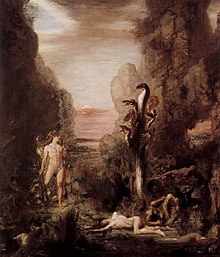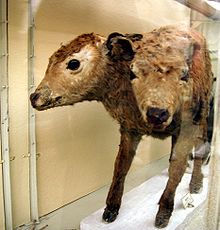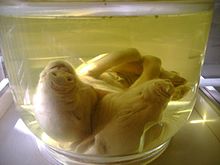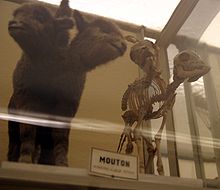Polycephaly: Difference between revisions
→Mythological occurrences: wiki-link |
m Adding a detail of controversy/ |
||
| Line 125: | Line 125: | ||
*[[Orochi]], an eight-headed snake in [[Japanese mythology]] |
*[[Orochi]], an eight-headed snake in [[Japanese mythology]] |
||
*[[Brahma]], a four-headed, four-faced [[Hinduism|Hindu]] god ([[Deva (Hinduism)|deva]]) |
*[[Brahma]], a four-headed, four-faced [[Hinduism|Hindu]] god ([[Deva (Hinduism)|deva]]) |
||
*[[Ravana]], the ten-headed King of [[Lanka]] from the [[Hinduism|Hindu]] [[smriti]] [[Ramayana]] |
*[[Ravana]], the ten-headed King of [[Lanka]] from the [[Hinduism|Hindu]] [[smriti]] [[Ramayana]](However, it is argued that Ravana's ten heads were just a figure of speech used to represent his superhuman intelligence) |
||
*[[Svantevit]], four-headed god of war and divination in [[Slavic mythology]] |
*[[Svantevit]], four-headed god of war and divination in [[Slavic mythology]] |
||
*[[Triglav (mythology)|Triglav]] (meaning "three headed") is a god or complex of gods in Slavic mythology |
*[[Triglav (mythology)|Triglav]] (meaning "three headed") is a god or complex of gods in Slavic mythology |
||
Revision as of 17:29, 12 October 2008

Polycephaly is a condition of having more than one head. The term is derived from the stems poly- meaning 'many' and kephal- meaning "head", and encompasses bicephaly and dicephaly (both referring to two-headedness). A variation is an animal born with two faces on a single head, a condition known as diprosopus. In medical terms these are all congenital cephalic disorders.
There are many occurrences of multi-headed animals, in real life as well as in mythology. In heraldry and vexillology, the double-headed eagle is a common symbol, though no such animal is known to have ever existed.
Bicephalic or tricephalic animals are the only type of multi-headed creatures seen in the real world and form by the same process as conjoined twins: they all result from the secondary union of two originally separate monozygotic embryonic disks. One extreme example of this is the condition of craniopagus parasiticus, whereby a fully developed body has a parasitic twin head joined at the skull.
Occurrences
Two-headed people and animals, though rare, have long been known to exist and documented. The "Scottish brothers" were conjoined twins, allegedly dicephalic, born 1460 (dates vary). (Human conjoined twins, not all of the dicephalic type, have been documented since the year 945.)
Novelty and study
Polycephalic animals often make local news headlines when found. The most commonly observed two-headed animals are tortoises and snakes.[1] Other species with known two-headed occurrences include cattle, sheep, pigs, cats, dogs, and fish. In 1894, a two-headed partridge was reported in Boston, Massachusetts.[2] It was notable as a dicephalic animal for surviving into adulthood with two perfect heads. Scientists have published in modern journals about dissecting such animals since at least the 1930s.[1] A 1929 paper studied the anatomy of a two-headed kitten.[1]
Polycephalic animals, due to their rarity, are a subject of novelty. "We", a two-headed albino rat snake born in captivity in 2000, was scheduled to be auctioned on eBay with an expected price tag of $150,000 (£87,000), though their policy of not trading in live animals prevented the sale.[3] On 2006-10-31, the World Aquarium[4] announced that "We" was adopted by Nutra Pharma Corporation, a biotechnology company developing treatments using modified cobra venom and cobratoxin.[5] "We" died of natural causes at age eight in June 2007, not long after the Corporation got him.[6]
Two-headed farm animals sometimes travel with animal side shows to county fairs. Many museums of natural history contain preserved two-headed animals. The Museum of Lausanne[7] in Lausanne, Switzerland, and the Ripley's Believe It Or Not! museum in Gatlinburg, Tennessee, have collections of preserved two-headed animals.
Anatomy and fitness
Each head of a polycephalic animal has its own brain, and they somehow share control of the organs and limbs, though the specific structure of the connections varies. Animals often move in a disoriented and dizzy fashion, with the brains "arguing" with each other; some animals simply zig-zag without getting anywhere[8] Snake heads may attack and even attempt to swallow each other. Thus, polycephalic animals survive poorly in the wild compared to normal monocephalic animals.[1]
Most two-headed snakes only live for a few months, though some have been reported to live a full life and even reproduced with the offspring born normal. A two-headed black rat snake with separate throats and stomachs survived for 20 years. "We", the two-headed albino rat snake, survived in captivity for 8 years. [9] There is some speculation that the inbreeding of snakes in captivity increases the chances of a two-headed birth.[10]
A famous successful modern case is that of the human dicephalic twins Abigail and Brittany Hensel, born in 1990. The twins have two heads, two hearts, three lungs, and two spinal cords, and share the other organs. Each twin controls the limbs on her "side", and with coordination can walk, run, and play piano.[11]
One or two animals?
It is difficult to draw the line between what is considered "one animal with two heads" or "two animals that share a body." With humans, dicephalic conjoined twins such as Abigail and Brittany Hensel are considered "twins", i.e., two individuals.[12] This makes sense as there is a range of conjoinedness, and non-dicephalic conjoined twins may be barely-conjoined and separable by surgery, as is the case with Chang and Eng Bunker. Although the Hensel twins only have one pair of arms and legs total, each twin controls one "side" of the body's limbs. On the other hand, Syafitri, born 2006 in Indonesia, were given one name by their parents because they only had one heart.[13] With other animals, polycephaly is usually described as "one animal with two heads."[3][14] One of the heads, especially in three-headed animals, may be poorly developed and malformed, and not "participate" much.[8]
Oldest occurrence
The February 22, 2007 issue of the journal Biology Letters detailed the discovery of a 120 million-year-old fossil of a 2-headed Hyphalosaurus lingyuanensis, marking the earliest known occurrence of axial bifurcation.[15]
List of recent occurrences
Humans
Dicephalic conjoined twins (dicephalus dipus):
- In 1990, Abigail and Brittany Hensel were born in Minnesota, United States[11]
- In 2000, Ayse and Sema were born in Kahramanmaraş, Turkey[16]
- In 2003, Sohna and Mohna were born in India[17]
- In 2006, Syafitri was born in Indonesia[13]
- In 2007, Mary Grace and Mary Divine Asis were born in the Philippines having only one heart. [18]
- In 2008, August 25, a baby boy named Kiron was born with two heads in south-western Bangladesh. [19] Kiron had been born from one embryo but a serious development anamoly had been present resulting in the double heads. The baby was described by the gynaecologist present at the birth as having "one stomach and he is eating normally with his two mouths. He has one genital organ and a full set of limbs". [19] However the clinic initially had been unable to determine whether he had one or two sets of vital organs. [19] The mother and baby had been taken to a hospital in Jessore, but the hospital staff had attempted to refer him to a more resourceful hospital in Dhaka in an attempt to save it. However the family lacked the money to take him there despite donations. [20] Although the baby had initially been healthy and was eating well, on August 26 the baby encountered breathing difficulties and a fever and subsequently died two days later on August 28.[20]
Craniopagus parasiticus - parasitic twin head with an undeveloped (or underdeveloped) body attached to the head of a developed twin:
- In 2003, Rebeca Martinez was born in the Dominican Republic with an extra head but died 7 hours after surgery at the age of 8 weeks.[21]
- In 2004, Egyptian Naglaa Mohamed gave birth to Manar Maged who had the head and undeveloped torso of another child attached. In 2005, the second head was removed, and later that year Naglaa appeared on the Oprah Winfrey show with her surviving child.[22] Manar died from a brain infection in 2006.[23]
Unconfirmed reports
- Maria and Consolata Mwakikoti from Tanzania (b. 1999)
- Luz and Milagros Romero-Saucedo of Argentina (b. 1999) may or may not be of the dicephalus type.
- Carmen and Lupita Andrade-Solis (b. 2000), originally from Mexico, currently resident in Connecticut, United States
- In 2008, a female child named Lali was born to Vinod and Sushma Singh of the Gautam Buddha Nagar district of Uttar Pradesh in India. [24] The family has refused special medical care, and recent reports state that the case is not one of polycephaly, but a condition called craniofacial duplication, a rare congenital disorder. [25]
Non-human animals
Cats

There have been numerous reports of two-faced cats; most die soon after birth. Reports of two-headed kittens are common, relative to other animals, because of their status as household pets. Recent two-headed kittens include:
- On 2000-06-07, Image, a two-faced kitten, was born on and died later that year in Philadelphia, Pennsylvania.[26][27]
- On 2005-03-08, Deuce, a two-faced kitten, was born in Lake City, Florida, and was euthanized shortly thereafter, having come down with pneumonia.[28]
- On 2005-06-12, Gemini, a two-faced kitten was born in Glide, Oregon.[29]
- On 2006-07-12, Tiger, a two-faced kitten was born in Grove City, Ohio.[30]
Polycephalic cats in museums include:
- The Museum of Lausanne in Lausanne, Switzerland, preserves a two-headed kitten (pictured).
- The Laing Museum in the small town of Newburgh, Fife, Scotland, preserves the stuffed body of a two-headed kitten born in the 19th century on Mugdrum Island.
- The Georgia State Capitol in Atlanta, Georgia, has a full body taxidermy of a two-faced kitten.
- Ripley's Believe It or Not! Museum on Clifton Hill in Niagara Falls, Ontario (Canada) has a full-body taxidermy of a two-faced kitten.
Cattle

- A head mount of a two-headed calf is on display in the Museum at the Georgia State Capitol Building in Atlanta, Georgia.
- A two-faced calf is preserved at the Douglas County Museum in Waterville, Washington.[31] The calf lived for ten days after birth.
- The Ripley's Believe It or Not! museum in Gatlinburg, Tennessee, has full body taxidermy of a two-headed calf.
- The Dalton Gang Museum, located in Meade, Kansas, also displays a full body taxidermy of a two-headed calf.
- A two-headed calf mount can be found at the Old State House in Hartford, CT
- A full taxidermy of a two headed calf can be found in Melton Mowbray museum, Leicestershire, Uk
- A full taxidermy of a two headed calf can be found in the Museum of Marxell (in the Northern Black Forest in Germany). The calf was born by a local cow and died shortly after birth by natural causes.
Pigs

- A two-headed piglet can be found at the Old State House in Hartford, CT
- In 1998, Rudy, a two-headed pig was born in Iowa.[1]
Goats and sheep

- In 2006, a two-headed lamb was born in Shandong, China.
- The Ripley's Believe It Or Not! museum in Gatlinburg, Tennessee, has a mount.
Reptiles
- A two-headed black rat snake with separate throats and stomachs survived for 20 years.
- There are several preserved two-headed snakes on display in the Museum at the Georgia State Capitol Building in Atlanta.[32]
Two-headed turtles and tortoises are rare but not unknown. Recent discoveries include:
- In 1999, a three-headed turtle was discovered in Tainan, Taiwan, by a villager named Lin Chi-fa.[8][1]
- In 2003, a two-headed angulate tortoise was discovered in South Africa, with the only other known case in the region reported in the early 1980s.[14]
- In 2004, Solomon and Sheba, a two-headed Mediterranean spur-thighed tortoise was born in Dorchester, England.[33]
- In 2005, a two-headed olive ridley sea turtle was found in Costa Rica by the World Wildlife Fund.[34]
- In 2005, a baby turtle of unknown species was also reported in Havana, Cuba, in 2005.[35]
- In 2006, a two-headed, five-limbed soft-shell tortoise in Singapore was also featured on a local television program, and again on another program in late 2006.[36]
- As of 2006, a living two-headed tortoise named Janus is being displayed in the Museum of Natural History of Geneva.[37]
- There is a full body mount of a crocodile with two heads located at the Georgia State Capitol on the top level.
- As of 2007, there is a fully preserved turtle named Emily with two heads at the Science Museum of Minnesota[38].
- There is currently living a two-headed turtle at the Homosassa Springs Wildlife State Park.
Mythological occurrences

Greek mythology
Greek mythology contains a number of multi-headed creatures. Typhon, a vast grisly monster with a hundred heads and a hundred serpents issuing from his thighs, is often described as having several offspring with Echidna, a creature with the body of a serpent but the face of a beautiful woman. Their offspring account for all the major monsters of Greek mythos, including:
- The Nemean Lion – a lion often depicted with multiple heads [citation needed]
- Cerberus – a monstrous three-headed dog that guards the gate to Hades
- Ladon – a sometimes hundred-headed serpentlike dragon that guards the garden of the Hesperides and is overcome by Heracles
- Chimera – sometimes depicted with the heads of a goat and a lion
- The Lernaean Hydra – an ancient nameless serpent-like chthonic water beast that possessed numerous heads
- Orthrus – a two-headed dog owned by Geryon
- The Hecatonchires were giants with fifty heads and one hundred arms. The word "Hecatonchire" means "hundred arms". They were the sons of Gaia, and Uranus.
- Hecate – Greek goddess of the crossroads, who had three heads to guard three-way crossroads
Other accounts state that some of these creatures were the offspring of Phorcys and Ceto. Phorcys is also said to have fathered Scylla, a giant monster with six dogs' heads, which terrorises Odysseus and his crew.

Other mythologies
- Balaur, a dragon with three, seven or twelve heads, in Romanian mythology
- Bune, a dragon with the heads of a dog, a griffin, and a man, in Christian demonology
- Janus, a two- or four-faced god in Roman mythology
- Kaliya, a multi-headed snake vanquished by Krishna in Indian mythology
- Nehebkau, a two-headed snake in Egyptian mythology
- Orochi, an eight-headed snake in Japanese mythology
- Brahma, a four-headed, four-faced Hindu god (deva)
- Ravana, the ten-headed King of Lanka from the Hindu smriti Ramayana(However, it is argued that Ravana's ten heads were just a figure of speech used to represent his superhuman intelligence)
- Svantevit, four-headed god of war and divination in Slavic mythology
- Triglav (meaning "three headed") is a god or complex of gods in Slavic mythology
- Zmey Gorynych, a dragon in Slavic mythology
- Dragons in Hungarian folklore usually have three or seven heads
- Double headed eagle, a heraldic symbol.
Modern fiction
Anatomical variation is less common in modern fiction than in mythology[citation needed]. Examples include:
- Zaphod Beeblebrox, in the Hitchhiker's Guide to the Galaxy
- Joe-Jim, from Robert A. Heinlein's Orphans of the Sky, is a mutant case of dicephalic conjoined twins.
- Mrs. Grales in A Canticle for Leibowitz
- Troigs from the Star Wars universe
- The two-headed panthers from the Lands of Lore series
- Charles and Mambo, the two-headed son of Eric T. Duckman in the animated sitcom Duckman
- Takhisis is a five-headed female dragon goddess in the Dragonlance novels and role-playing games.
- The bird Pokemon Doduo and Dodrio, with two and three heads, respectively.
- Tom and Barry Howe in Brothers of the Head by Brian Aldiss, conjoined twins with a third, dormant head
- Zak and Wheezie, brother and sister dragons with one body in Dragon Tales
See also
- Conjoined twins
- Chimera
- Tripartite deities & legendary creatures
- Cephalic disorder
- Diprosopus
- Supernumerary body part
- Polymelia
- Polydactyly
- Vladimir Demikhov
References
- ^ a b c d e f Anina, Svetlana (2003-11-29). "Two-Headed Creatures". Retrieved 2006-12-31.
{{cite web}}: Check date values in:|date=(help); Unknown parameter|Publisher=ignored (|publisher=suggested) (help) - ^ "A two-headed partridge". The Washington Post. 1894-05-06. Retrieved 2006-12-31.
{{cite web}}: Check date values in:|date=(help) - ^ a b "Two-headed snake 'up for auction'". BBC News. Retrieved 2006-03-10.
- ^ "World Aquarium". Retrieved 2006-12-31.
- ^ "Nutra Pharma Adopts Famous 2-Headed Snake of St. Louis' World Aquarium".
- ^ "'We' the 2-headed snake's long odd life ends". MSNBC. Retrieved 2007-06-20.
- ^ "Le Musée cantonal de Géologie(The Museum of Lausanne)". Retrieved 2006-12-31.
- ^ a b c "Three-headed turtle destined not to go far". Associated Press. 1999-01-27. Retrieved 2006-12-31.
{{cite web}}: Check date values in:|date=(help) - ^ ["http://www.msnbc.msn.com/id/19334041/" "'We' the 2-headed snake's long life ends"].
{{cite web}}: Check|url=value (help); Cite has empty unknown parameter:|1=(help) - ^ Mayell, Hillary (2002). "Life Is Confusing For Two-Headed Snakes". National Geographic News. Retrieved 2006-03-10.
{{cite web}}: Unknown parameter|month=ignored (help) - ^ a b Chang, Maria L. (1996-10-04). "Joined for life - co-joined six-year-old Hensel twins share many body parts". Science World. Retrieved 2006-12-31.
{{cite web}}: Check date values in:|date=(help); Text "Science World]]" ignored (help) - ^ Wallis, Claudia (1996-03-25). "The most intimate bond: Conjoined for life, the Hensel twins are a medical mystery and a lesson in cooperation for us all". Time magazine. Retrieved 2006-12-31.
{{cite web}}: Check date values in:|date=(help) - ^ a b "Conjoined twins still a mystery". The Jakarta Post. 2006-08-26. Retrieved 2006-12-31.
{{cite web}}: Check date values in:|date=(help) - ^ a b Swarts, Candice (2003-05-30). "Rare Two-Headed Tortoise Found in South Africa". National Geographic News. Retrieved 2006-03-10.
{{cite web}}: Check date values in:|date=(help) - ^ Prehistoric Reptile Fossil Found With Two Heads
- ^ "Conjoined twins' first steps (In Turkish)". Radikal. Retrieved 2008-11-04.
- ^ Rana, Yudhvir (2004-06-05). "Bound by destiny, life may be a bind for them". Times of India. Retrieved 2006-12-31.
{{cite web}}: Check date values in:|date=(help) - ^ "Doctors vow to save dicephalus twins from death". GulfNews. 2007-04-24. Retrieved 2007-04-26.
{{cite web}}: Check date values in:|date=(help) - ^ a b c "Two-headed baby born in Bangladesh". The Sydney Morning Herald. August 28 2008. Retrieved August 28.
{{cite web}}: Check date values in:|accessdate=and|date=(help); Unknown parameter|accessyear=ignored (|access-date=suggested) (help) - ^ a b "A baby boy born with two heads has died after developing a fever and breathing difficulties, a Bangladeshi doctor says". Sky News. August 28 2008. Retrieved August 28.
{{cite web}}: Check date values in:|accessdate=and|date=(help); Unknown parameter|accessyear=ignored (|access-date=suggested) (help) - ^ "Two-Headed Baby Dies After Surgery". CBS News. 2004-02-07. Retrieved 2007-02-08.
- ^ "It's a Miracle! The Two-Headed Baby!". 2005-05-19. Retrieved 2007-02-08.
{{cite web}}: Check date values in:|date=(help) - ^ "Doctors unable to save two-headed girl". 2006-03-27. Retrieved 2008-08-18.
{{cite web}}: Check date values in:|date=(help) - ^ "Indian woman gives birth to 'miracle' child". Telegraph. 2008-03-18. Retrieved 2008-03-18.
{{cite web}}: Check date values in:|date=(help) - ^ "India two-faced baby's family refuses special care". Reuters. 2008-04-10. Retrieved 2008-04-10.
{{cite web}}: Check date values in:|date=(help) - ^ "Two-Faced Kittens". 2000-06-07. Retrieved 2006-03-10.
{{cite web}}: Check date values in:|date=(help) - ^ Gomez, Nicole (2000-06-10). "Two-Faced Kitten Has Image Problem". Retrieved 2006-12-31.
{{cite web}}: Check date values in:|date=(help) - ^ "Kitten Born With Two Faces". newsnet5. 2005-03-10. Retrieved 2006-12-31.
{{cite web}}: Check date values in:|date=(help) - ^ Traylor, Dan (2005-06-16). "Two-faced kitten shocks owner, veterinarian". The News-Review. Retrieved 2006-12-31.
{{cite web}}: Check date values in:|date=(help) - ^ "Kitten Born With Two Faces, One Body". NBC6 South Florida. 2006-07-17. Retrieved 2006-12-31.
{{cite web}}: Check date values in:|date=(help) - ^ Ellington, Luke. "THE TOWN OF WATERVILLE". Retrieved 2006-03-10.
- ^ "Georgia Capitol Museum". AOL Cityguide. Retrieved 2006-03-10.
- ^ "Shell shock at two-headed tortoise". BBC News. 2004-11-12. Retrieved 2006-12-31.
{{cite web}}: Check date values in:|date=(help) - ^ "Two-headed turtle found in Costa Rica". 999Today. 2005-12-01. Retrieved 2006-03-10.
{{cite web}}: Check date values in:|date=(help) - ^ "Two-headed turtle found in Havana, Cuba". mongabay.com. 2005-10-01. Retrieved 2006-03-10.
{{cite web}}: Check date values in:|date=(help) - ^ "The Chinese Garden (Yu Hwa Yuan)".
- ^ "Culture in Geneva". Retrieved 2006-03-10.
- ^ Science Museum of Minnesota - Collections Gallery
External links
- "Two-headed animals going on show" at Newsround Online (accessed August 24, 2006).
- Video of two-headed piglet.
